Choosing a family car is often a challenging process, as it needs to fulfill the role of the ultimate all-rounder. The ideal family vehicle faces a nearly impossible task—buyers expect it to be affordable without feeling cheap, spacious enough for the whole family but still easy to maneuver and park, flawlessly safe yet straightforward to use, and capable of delivering impressively low running costs.
In past decades, the go-to family car in the UK was typically a mid-sized saloon, with the estate version favored for those needing extra room. Moving into the 1990s and 2000s, hatchbacks like the Volkswagen Golf became the standard choice, and the emergence of seven-seat MPVs met the needs of larger families.
By 2025, the trend has clearly shifted toward SUVs as the preferred family vehicle—and it’s easy to see why. As reflected in our top 10 list below, modern SUVs come in a wide range of shapes and sizes.
Whether you’re after a compact model or a spacious seven-seater, there’s something for everyone, with options spanning electric, hybrid, and traditional petrol or diesel powertrains.
However, it’s important to note that not all family-friendly options are SUVs. Some of the most dependable and beloved family cars remain hatchbacks or MPVs that deliver practicality through more traditional designs.
There’s truly a vehicle for every type of buyer and budget, whether you’re looking to keep expenses minimal or treat your family to a more luxurious option. Likewise, whether you have one child or a full house, there are models that cater to every family size.
Despite their differences, the cars on our list share a number of important qualities—they’re all economical to run, enjoyable to drive, cleverly practical for their size, and offer an ownership experience that’s genuinely satisfying.
Many of our writers have families themselves, so we go the extra mile to check things like how easily child seats install in the rear, whether a buggy fits in the boot, and how well the cabin materials hold up against sticky fingers.
1. Hyundai Santa Fe
In fact, the Santa Fe didn’t just stop there; it also won our overall Car of the Year title and helped Hyundai clinch the Brand of the Year accolade.
The Santa Fe excels as a family car because of the exceptional thought and care put into its design. It offers seating for seven across three rows, with even the third row being spacious enough to accommodate adults in comfort.
The boot provides decent space even with all seats in use—more than enough for a weekly grocery haul. Drop the third row, and you’re left with a cavernous five-seater that can handle even the most oversized buggies.
Need to stash smaller items? The Santa Fe has you covered with an abundance of cleverly placed cubbyholes—there are 17 cupholders, ideal for when everyone on board has multiple drinks on hand.
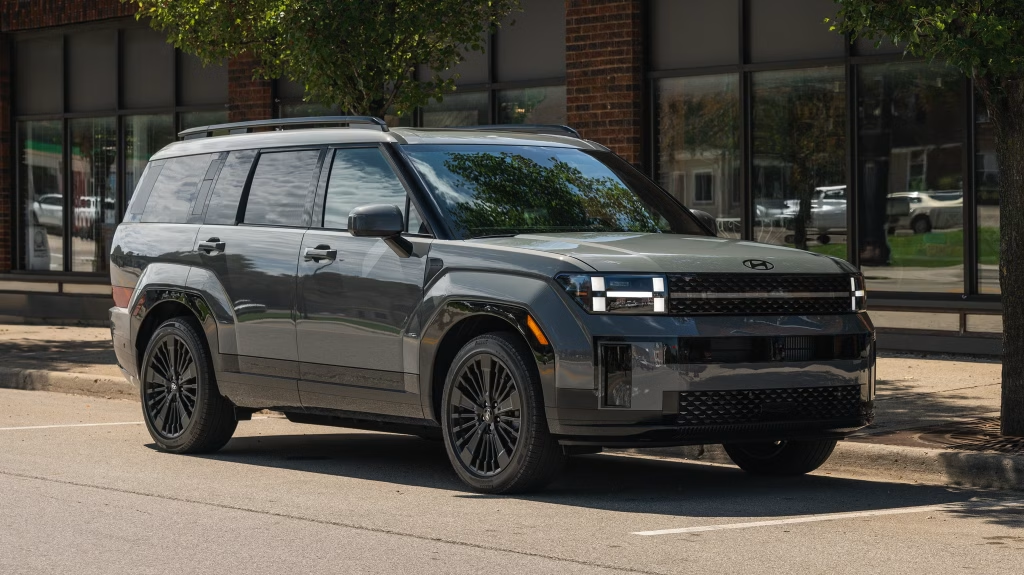
Safety is another strong point. The Santa Fe earned a full five-star rating from Euro NCAP when equipped with the safety pack, which comes standard in UK models. It also includes four ISOFIX mounting points in the rear for added child seat security.
Despite its boxy, futuristic design—complete with sharp lines and LED accents—the Santa Fe doesn’t handle like a heavy block. It offers two engine choices: a self-charging hybrid or a plug-in hybrid.
While not built for speed, both options deliver more than enough power for day-to-day driving, offering a smooth, composed ride that handles bumps comfortably without wallowing in corners.
And here’s the kicker: at roughly two-thirds the cost of a comparable SUV from a premium brand, the Santa Fe delivers impressive value. It’s not exactly budget-tier, but it feels like a meticulously engineered, high-quality vehicle that absolutely earns its place on your driveway.
2. Skoda Superb
The Skoda Superb proves that you don’t need to drive a large, bulky SUV just to get a spacious interior and a huge boot. This understated yet stylish car delivers limousine-level space, especially in the rear seats, where even the tallest teenagers or the most oversized child seats will fit comfortably without compromising the legroom of front passengers.
The boot is equally generous, offering 645 litres of storage in the hatchback and an even larger 690 litres in the estate version—enough for even the most storage-hungry families.
Up front, the Superb continues to impress with a well-crafted interior packed with thoughtful details like configurable digital dials that strike a great balance between touchscreen flexibility and traditional controls.
You’ll also find Skoda’s signature ‘Simply Clever’ features, including a windscreen ticket clip and cupholders with grips that let you open bottles one-handed.
The Superb is available with petrol and diesel engines, and the estate offers a plug-in hybrid with a long electric range. Regardless of the version, it delivers a smooth, refined drive and outstanding comfort, particularly on long motorway journeys.
While the suspension can feel a bit firm around town, and the digital driver’s display may be confusing for some, the Superb’s blend of practicality, comfort, and quality is tough to beat. Prices start at £33,488 for new models and from £28,578 for used ones.
3. Citroen C5 Aircross
The Citroen C5 Aircross is a standout in the value-for-money category, offering an attractive alternative to budget brands like Dacia or MG. Despite its low starting price, this SUV doesn’t feel cheap.
Instead, it presents itself as a well-equipped, comfortable, and surprisingly refined family car. Citroen’s ‘Advanced Comfort’ suspension lives up to its name, effortlessly absorbing bumps and making for a smooth urban ride.
The engine lineup includes a 1.2-litre hybrid that performs better than expected, a plug-in hybrid ideal for home charging, and a rare but welcome diesel option for high-mileage drivers. Family practicality is one of the C5 Aircross’s strongest assets.
The boot is spacious—though slightly reduced in hybrid models—but the real gem is in the rear seating setup. Unlike most rivals, the C5 Aircross has three individual rear seats, each with ISOFIX mounts and independent sliding and folding capabilities.
This layout allows for three child seats across the back, which is a game-changer for larger families. The SUV’s stylish design, comfortable ride, and smart use of space make it a highly commended option.
It does have a few shortcomings, such as some cheap interior elements and a slightly clunky infotainment system, but its strengths far outweigh its flaws. New prices begin at £24,898 (or £214/month), while used models are available from just £8,195.
The Citroën C5 Aircross embodies the brand’s signature design philosophy, blending comfort with a unique aesthetic. While its shape might not be immediately recognizable as a typical Citroën, the vehicle is marketed as a “Comfort class SUV” in its brochure, living up to that title with its notably supple ride.
The design of the C5 Aircross is distinctively quirky, a characteristic that only Citroën, renowned for its avant-garde design approach, could pull off.
Beneath its eye-catching exterior, the C5 Aircross shares many mechanical and engine components with the Peugeot 5008—a fellow Stellantis model that is one of our top choices for a seven-seater SUV.
Although the C5 Aircross only comes with five seats, it offers a range of engine options, including petrol, diesel, and a plug-in hybrid. The vehicle is priced competitively, making it an attractive choice in the segment, competing against more affordable models like the Dacia Jogger, Ford Kuga, Mazda CX-5, and MG HS.
With its combination of a smooth ride, affordable price, and five-seat configuration, the Citroën C5 Aircross is certainly appealing to those looking for a well-rounded family SUV. In this review, we’ll delve into the details of the C5 Aircross to give you a clearer picture of what it has to offer.
Focusing on comfort and refinement, the Citroën C5 Aircross stands out as a great-value family SUV, especially when opting for the entry-level 1.2-litre petrol engine and Plus trim.
While it offers several strengths, those looking for a more plush interior, sharper handling, or the option of seven seats might prefer the closely-related Peugeot 5008 instead.
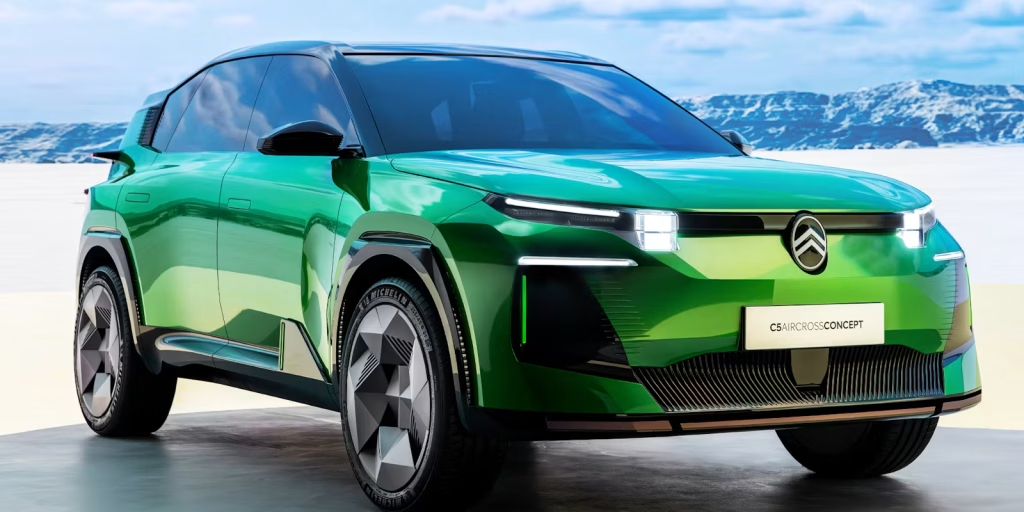
The C5 Aircross offers a supremely smooth ride, a quiet interior at high speeds, and efficient engines, though its handling can feel wallowy, the infotainment system can be fiddly to use, and rear legroom is somewhat tight for the class.
In terms of performance, the 129bhp 1.2 Puretech 130 petrol engine is the standout choice for keeping costs to a minimum. It performs well at lower revs, easily reaching motorway speeds without much effort. For even greater fuel efficiency, there’s an option to go for a 48V mild-hybrid system, although it comes at a higher price.
For those in need of more power or intending to tow, the 1.5-litre BlueHDi 130 diesel engine offers more low-end torque and a more relaxed driving experience, even if acceleration at traffic lights is similar to the petrol engine.
If efficiency is your priority, the plug-in hybrid (PHEV) with 222bhp is the most powerful and smoothest engine in the C5 Aircross lineup.
The 13.2kWh battery and electric motor ensure a seamless drive with no hesitation when accelerating, and the official all-electric range of up to 41 miles could help reduce both emissions and running costs.
Citroën has made bold claims about the comfort of the C5 Aircross, and it’s clear that these claims hold up. The vehicle provides a pillowy, soft ride that easily absorbs bumps and imperfections, making it one of the most comfortable SUVs for its price, particularly on A-roads and motorways.
However, it’s not flawless—while it handles smooth surfaces with ease, it can thud over sharp imperfections and sway slightly over undulations. If you prefer a more composed ride, the Peugeot 5008 may be a better option.
The weightier PHEV version requires a firmer suspension setup, but it remains softer than most competitors, and this added firmness helps minimize the floatiness experienced in non-hybrid versions.
As for handling, the C5 Aircross is not the most agile SUV on twisty roads. It grips well enough but tends to lean excessively in bends, more so than rivals such as the Seat Tarraco and VW Tiguan Allspace, even among seven-seater SUVs. The PHEV version, being heavier, exacerbates this issue, making it even less suitable for winding roads.
If you’re looking for a more engaging drive on twisty routes, the CX-5 or PHEV Kuga would be better choices. Even if the wallowy handling doesn’t deter you, the steering can be disappointing.
While it’s light and easy to maneuver in urban settings, it offers little feedback at higher speeds on A and B roads. Switching to Sport mode adds a bit more resistance, but it doesn’t significantly improve the connection to the road, and you’ll still struggle to get a true sense of what the front wheels are doing.
4. Dacia Duster
The Dacia Duster may have a three-star Euro NCAP safety rating, but don’t let that dissuade you—it’s not as unsafe as it may initially appear. A closer look reveals that, in terms of crash protection, the Duster actually scored four stars.
While it may not feature the advanced active safety systems that would boost its Euro NCAP score, Dacia focuses on passive safety features, ensuring the car is still a solid and safe choice for families. While there are certainly safer vehicles on the market, the Duster is by no means dangerous to travel in.
Beyond safety, the Dacia Duster impresses with its rugged simplicity. The interior is basic but smartly designed, prioritizing functionality over luxury. Dacia has focused its budget on creating a tough, durable car rather than offering high-end finishes.
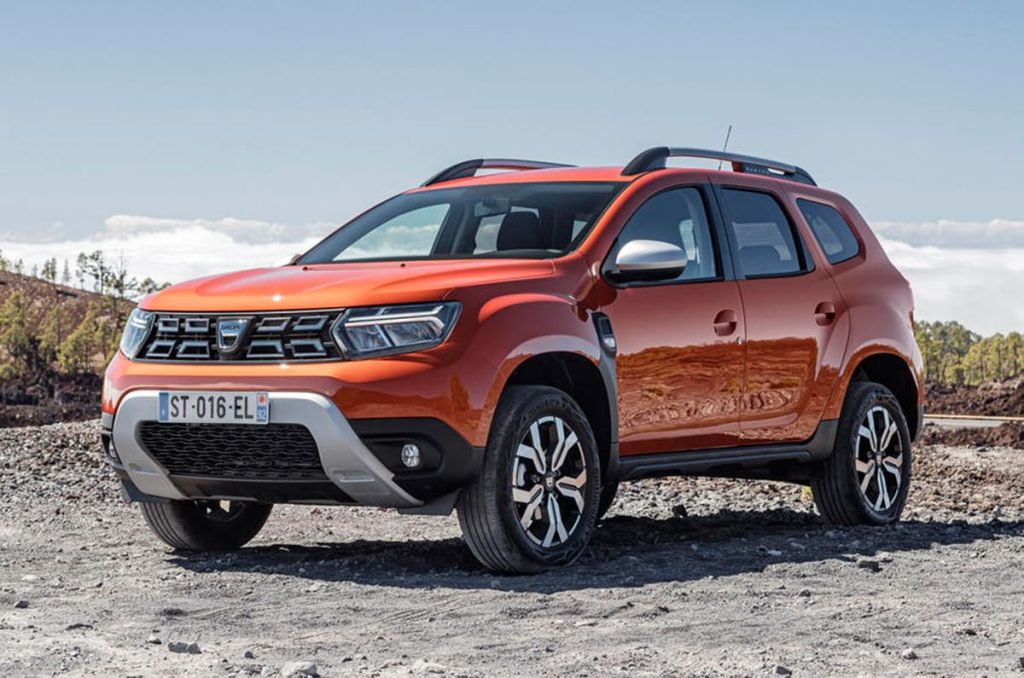
The car comes equipped with a straightforward touchscreen infotainment system, but most drivers will likely connect via Apple CarPlay or Android Auto for a more user-friendly experience.
The Duster offers ample space in the back seats and a generously sized boot, plus the innovative YouClip system that allows you to attach a variety of accessories to the interior, such as phone mounts, tablet holders, and even pencil pots.
An efficient hybrid engine is available, but the Duster also offers a four-wheel-drive version that performs impressively on rough terrain, maintaining the vehicle’s rugged character.
For families looking for great value, the Duster is a solid choice, though the interior does feature cheap plastics, and the seats don’t fold completely flat. Additionally, the diesel option is no longer available. New models start at £18,657 (or £250/month), though used Duster units are currently unavailable.
5. BMW X5
While it may not be the most affordable or the most attractive SUV on the market, its performance and features more than make up for these drawbacks. The X5 boasts an impressive engine lineup, with even the base model featuring a smooth, powerful six-cylinder engine that’s both efficient and enjoyable to drive.
For those prioritizing efficiency, the X5 plug-in hybrid offers a fantastic balance of power and performance, combining the six-cylinder engine with a large battery and electric motor to provide an all-electric range of around 60 miles, making it an excellent choice for everyday use.
The BMW X5 offers five seats and a large boot, but if you need additional capacity, the petrol and diesel versions can be configured with seven seats, offering extra flexibility for larger families.

Inside, the X5 impresses with its luxurious, high-quality interior, which is both packed with technology and durable enough to withstand the demands of family life. For even more space, the larger BMW X7 is an option, though it’s generally considered less attractive.
While the X5 is a top contender in terms of driving pleasure and practicality, it does come with a few drawbacks: lumbar adjustment is only available as an option, the M50d model includes fake engine noise, and it can feel firm on large alloy wheels. The X5 starts at £65,711 (or £700/month), and used models are available from £28,995.
Worst Cars For Family
Drivers searching for a family car are typically looking for a vehicle that offers practicality, ample space, and, most importantly, reliability.
The last thing parents want is to be stranded on the roadside with their children, waiting for a recovery service, or facing a hefty repair bill because their car has broken down once again.
Fortunately, various car owner surveys allow drivers to share their experiences, highlighting whether their vehicle is dependable or not. The survey includes only cars that are up to five years old, covering a range of models that are either currently available in showrooms or highly sought after as nearly-new used cars.
Reliability ratings are based on several factors: the frequency and severity of faults reported by owners over the past 24 months, the cost of repairs, and how long the car was off the road during that period.
5. Volkswagen Golf (2020-present)
The Mk8 Volkswagen Golf was introduced in 2020, but it has proven to be less reliable than the model it replaced. Nearly two-thirds of owners have reported experiencing at least one fault with their vehicle over the past 24 months.
Remarkably, the current Golf (Mk8) fares even worse than its predecessor in terms of reliability, based on feedback from owners. Despite being a relatively new release, 39 percent of owners have experienced at least one issue with their car within the last two years.
The most common issues reported were non-engine electrical problems, such as glitches with the sat nav and infotainment system, which accounted for 24 percent of all faults. Owners also reported problems with the air conditioning system, as well as issues with the battery, bodywork, engine, fuel system, and suspension.
Moreover, two in five of these vehicles took more than a week to repair. A small proportion of owners had to pay between £751 and £1,500 for repairs.
The 2025 Volkswagen GTI introduces several notable updates, including a larger touchscreen, an enhanced voice assistant, and upgraded infotainment software.
The car also features new steering-wheel controls, replacing the touch-sensitive buttons that were previously criticized, offering a more user-friendly experience. Additionally, the updated GTI comes with revised headlights, taillights, and new wheel designs.
However, one significant change is that the 2025 model no longer offers a manual transmission, with the 2024 GTI 380 edition marking the last chance to shift gears yourself.
The starting price for the 2025 Volkswagen Golf GTI is $33,670, with prices reaching up to $42,105 depending on the trim and options selected.
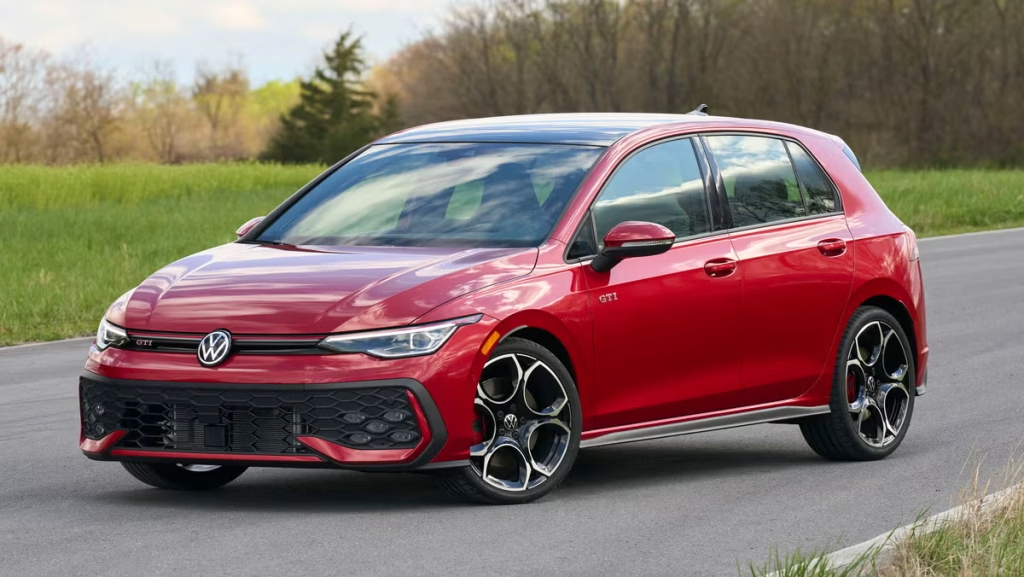
The available trims include the base S at $33,670, the SE at $38,645, and the Autobahn at $42,105. With the manual transmission no longer an option, the GTI S becomes an attractive choice, especially as it now comes standard with a larger 10.9-inch infotainment screen, an updated operating system, and navigation.
While the Autobahn trim offers additional luxury and performance features like adaptive damping, the S trim retains the essence of the classic GTI, making it a solid option for enthusiasts.
Under the hood, the 2025 Golf GTI continues to use a turbocharged 2.0-liter inline-four engine, producing 241 horsepower, which remains the same as the previous model.
The only available transmission is a seven-speed dual-clutch automatic, replacing the six-speed manual. Although the dual-clutch system provides quick shifts, it is less engaging than the manual transmission.
Nevertheless, the automatic GTI still offers an enjoyable driving experience, with a firm brake pedal and a responsive handling feel that makes it fun to drive, especially on twisty roads. While the steering could benefit from more feedback, the car retains the dynamic performance that GTI drivers expect.
In terms of performance, the 2025 GTI is expected to deliver similar 0-60 mph times to its predecessor, which achieved 5.7 seconds with the dual-clutch automatic transmission.
We will update this section with precise test results once we have the opportunity to test the new model. As for fuel efficiency, the 2025 Golf GTI is rated by the EPA to deliver 24 mpg in the city, 32 mpg on the highway, and 27 mpg combined.
Although we haven’t yet tested the automatic version on our 75-mph highway fuel-economy route, the previous GTI S with the six-speed manual achieved 37 mpg during that test, offering a glimpse into the potential efficiency of the new model.
4. Skoda Yeti (2009-2017)
The Skoda Yeti is known for its practicality, but it falls short when it comes to dependability. The most common issues with this vehicle are gearbox and clutch problems, which tend to be costly to fix.
The Yeti was one of Skoda’s top family car offerings, built on the same platform as the Volkswagen Golf. It featured a boxy design that provided more headroom for passengers, increased boot capacity, and a more flexible cabin layout. However, in terms of reliability, it scored only 79.2 percent, with a third of owners reporting faults in the past 24 months.
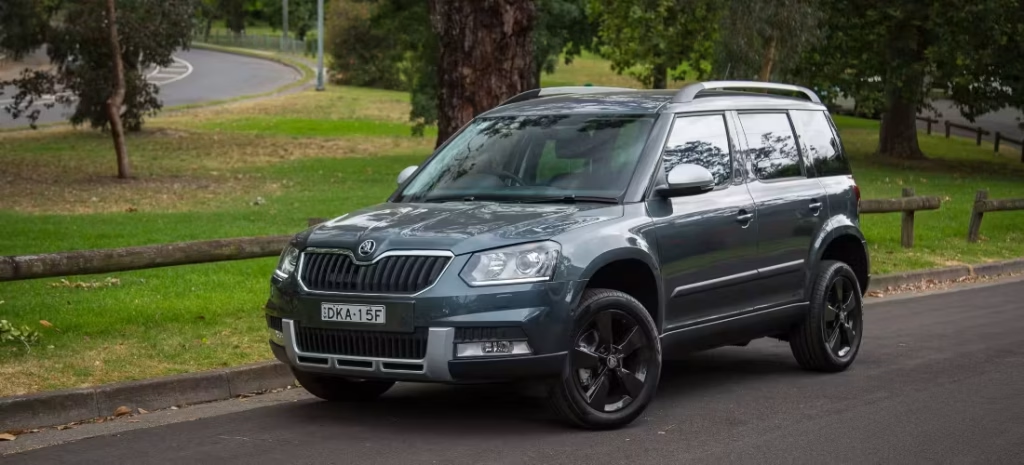
Gearbox and clutch problems were the most frequent complaint, followed by issues with the air conditioning, bodywork, brakes, electrics, sat-nav, and suspension. Given the significant cost of gearbox and clutch repairs, it’s not surprising that three-quarters of cars were in the garage for more than a week.
Since the Yeti was discontinued in 2017, most of these vehicles were no longer covered by a warranty, meaning owners had to cover the repair costs themselves. Half of the owners spent up to £500, while 13 percent paid up to £1,000 for repairs.
3. Skoda Octavia (2020-present)
The current Skoda Octavia takes the bronze medal in the category of least reliable family cars. More than half of the owners (54 percent) reported experiencing a fault with their vehicle within the last 24 months.
Among the most common issues for the Octavia were problems with the satellite navigation and infotainment systems, affecting 31 percent of the vehicles. Another 27 percent had electrical problems.
While these issues were generally not serious, they still caused inconvenience, with a third of affected cars spending more than a week in the shop. Fortunately, all owners benefited from the new car warranty, which helped avoid costly repair bills for these issues.
The Skoda Octavia has evolved in several aspects over the years, but in the key areas where it has always excelled—comfort, practicality, and value for money—it remains unchanged.
The fourth-generation model debuted in 2020, and earlier in 2024, it received some styling updates and a revised engine lineup. Despite these changes, it continues to offer the same high-quality family car experience with an abundance of space that it has been known for.
The facelift arrived when the car was still performing strongly in its segment, meaning the revisions, which included a refreshed exterior and updated technology, didn’t need to be drastic to maintain the vehicle’s competitiveness.
One of the most significant updates is the introduction of a ‘low-power’ 1.5 TSI petrol engine. This engine replaces the previous 1.0 TSI three-cylinder unit and is a detuned version of the four-cylinder engine found in other Octavia variants.
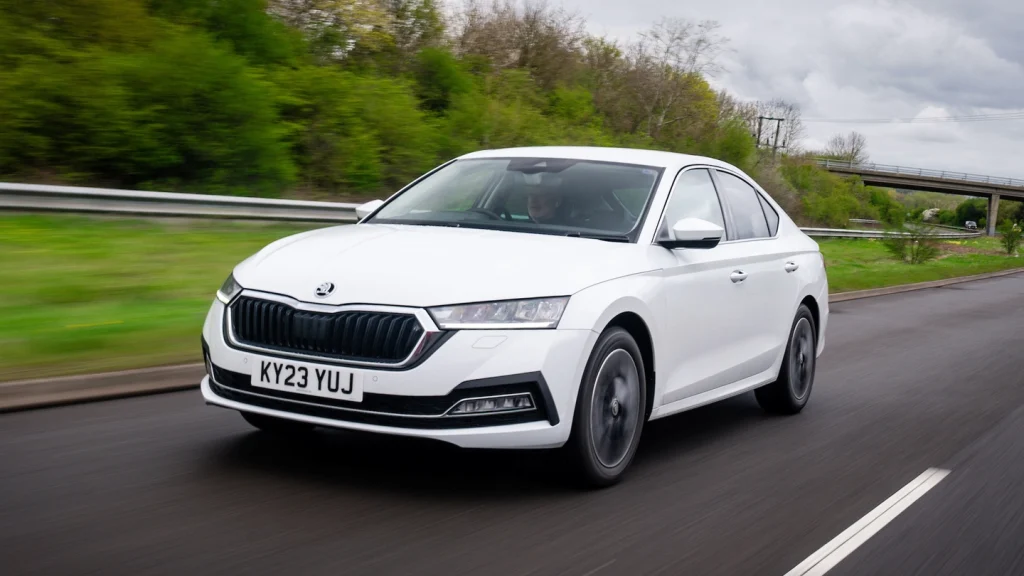
The new engine produces 114bhp (5bhp more than the 1.0 TSI) and 220Nm of torque, resulting in a smoother and more responsive driving experience while offering similar fuel efficiency. For those looking for more power, the higher-output version of this engine generates 148bhp and 250Nm of torque.
Both versions of the petrol engine are available with either a six-speed manual or a seven-speed DSG automatic gearbox, with the automatic variant incorporating mild-hybrid technology to help reduce emissions.
Additionally, there is a 2.0-litre diesel engine available, offering 114bhp in the manual version and 148bhp in the automatic. However, the diesel automatic version does not feature the mild-hybrid system.
The Skoda Octavia vRS models are equipped with a more powerful 261bhp 2.0-litre petrol engine. While we haven’t tested the facelifted vRS yet, previous iterations have been well-received for their performance and handling.
Although the Octavia continues to be offered as both a five-door hatchback and an estate, Skoda has streamlined the trim levels, offering the SE Technology, SE L, and SportLine variants.
The well-equipped SE Technology trim starts at around £27,000, placing it at a similar price point to the Volkswagen Golf, a model that used to command a premium. The higher-spec SE L and SportLine trims, equipped with the more powerful engines, are priced around the £35,000 mark, while the vRS model comes in closer to £39,000.
2. Mercedes-Benz A-Class HYBRID (2018-present)
Previously, we’ve discussed the petrol and diesel versions of the Mercedes-Benz A-Class, and now it’s time to focus on the hybrid variants. Engine-related issues are among the most common complaints, and these tend to be costly to repair.
For the third time, the current-generation Mercedes-Benz A-Class makes an appearance on this list, with the hybrid version claiming the title of the second least reliable family car.
Nearly half (46 percent) of hybrid A-Class owners reported experiencing a fault with their vehicle. The engine, both engine-related and non-engine electrical issues, and air-conditioning problems were the primary areas of concern.
Although 79 percent of repairs were covered under warranty, 14 percent of hybrid A-Class owners had to pay for repairs themselves. In some cases, these repair costs reached as high as £1,500. Fortunately, three-quarters of the affected cars were repaired and returned to their owners within a week.

For those seeking diesel power in the Mercedes A-Class, the A200d is the only engine option—and it doesn’t disappoint. It’s quick, delivering a smooth and progressive power curve that’s evenly distributed throughout the rev range. It can accelerate from 0-62mph in just 8.3 seconds, making it a lively choice for those who want solid performance.
When it comes to petrol options, the entry-level A180 does require a bit of effort to keep pace with traffic. While the automatic gearbox does a decent job of keeping the car in the right gear to maintain momentum, the more powerful A200 offers a noticeably better performance.
Officially, the A200 can achieve 0-62mph in 8.2 seconds, which is quicker than both the Audi A3 35 TFSI and BMW 118i, making it the preferable choice among the petrol engines.
For those who crave even more speed, the high-performance versions of the A-Class—such as the Mercedes-AMG A35 and Mercedes-AMG A45—would be the ideal options. For detailed reviews of these hot hatch models, refer to our reviews of the A35 and A45.
1. Audi A3 (2020-present)
The Audi A3 has earned the distinction of being the least reliable family car in What Car?’s report. Surprisingly, this is a premium vehicle, not a budget option.
A staggering 57 percent of owners reported encountering issues with their A3 in the last two years, and three-quarters of these vehicles were off the road for more than a week for repairs.
The latest-generation Audi A3 ranks as the least reliable family car according to the dependability survey conducted by the consumer magazine. Of all the A3 owners who participated in the survey, 57 percent said they had experienced a malfunction within the past two years.

The most common issue reported was problems with the sat nav and infotainment system, which accounted for a third of the complaints.
Another 29 percent of owners reported electrical faults, indicating that there are some persistent technical issues with the A3. Other problems included issues with the battery, gearbox/clutch, interior trim, and bodywork.
While all repairs were covered by the warranty, many of the issues were serious and required extensive time to fix. This is why 38 percent of the affected cars were undriveable while being repaired, and 76 percent spent over a week in the garage.

